A guide to building Classic Town cars
Posted by Huw,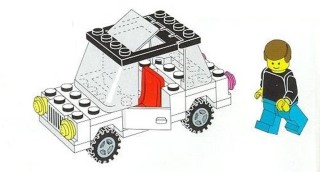
This part-historical, part-building tutorial article has been contributed by WoutA:
I recently started building my own LEGO classic town, Crusader City. Around the grey castle and its park in the centre, I installed a fire and police station, customs and post offices, a bookshop, houses, a gas station, a snack bar and other LEGO sets from 1978, when the minifigure was introduced, until 1993. But obviously, a LEGO town is no LEGO town without all kinds of cars cruising the streets.
Some of the sets I built already featured vehicles, such as the 379 Bus Station, 6382 Fire Station, 6362 Post Office and 6384 Police Station. But these were all utility vehicles, used to catch criminals, extinguish fires or deliver the mail or people to the right destination.
So I dived into the history of LEGO cars and wanted to share what I found with you.
Cars have been part of much of LEGO’s history, going way back to the HO sized metal vehicles in the early days of the Town Plan. For my investigation however, I concentrated on cars that are designed to seat the minifigures with flexible arms and legs as we still know them today. I also excluded construction vehicles, trucks and race cars, as I wanted to crowd the Crusader City streets with what one could call ‘family cars’. In this article I do refer to some utility vehicles as I believe these could inspire family cars or could easily be converted to them.
Simply searching for ‘LEGO car’ didn’t exactly give me what I was looking for. I first had to reduce my search results to the classic town period. Even then, names didn’t say much. For example, 6363 Auto Repair Shop from 1980 has no car but only a tow truck. The vehicles in 1966 Car Repair Shop are buggys rather than automobiles.
Instead, I looked through all the LEGO town and train sets and most of the idea books from 1978 until the early nineties approximately. Most of the cars found in these use a 4x10 or a 4x7 base. A beautiful exception is the old-timer found in 1592 Town Square - Castle Scene from 1980, which is built on a simple 2x8 plate, just like the car in 6679 Exxon Tow Truck from that same year. LEGO Idea Book 200 Building Ideas Book from 1985 has instructions for an adorable tiny car on a 2x6 plate, which I managed to shrink even further down to a 4x5 car, the tiniest one possible in minifigure scale, I believe.
In a purely subjective manner, I picked what I thought to be the most iconic example for each of the two vehicle base. The 4x10 classic town car can be found, with only slight changes, in a number of sets, including 6371 Shell Service Station, 6374 Holiday Home and 6633 Family Car. The classic town car with a 4x7 base has seen more variations, but I’ll take one of its earliest appearances, in 1484 Houses, as a reference. Now let’s see how these are built and how all of their components evolved over the years.
Step 1: vehicle base
With the flexible minifigure, a 4x10x2/3 vehicle base (part number 4212) was also introduced in 1978. It has a recessed centre, to sit the minifigure down straight or to install a chair, and cutouts which allow you to attach wheels. The first three years, a version with a centre hole was used in ten sets in three colours. White ones only appeared in police vehicles while there were also black and red ones.
The 6627 Convertible from 1980, a great little car, saw the first appearance of the red 4x10 vehicle base, this time without the centre hole. Versions in black, white and yellow were released in 1982. Interestingly, the white one was first used not for a car but for the 6890 Cosmic Cruiser, a classic LEGO spaceship.
The 4x10 chassis only appeared in blue in two sets: 6346 Shuttle Launching Crew from 1992 and 1376 Spider-Man Action Studio from 2002. A version in dark bluish grey was used in three sets before the 4x10 vehicle base was discontinued in 2011.
In 1987, LEGO introduced a smaller 4x7x2/3 vehicle base (2441 CHASSIS 4X7) in black, white, red and blue. It was featured in over 115 sets so far and, contrary to the 4x10 base, is still in use today. A year after its first appearance, a version in yellow was added, while the green one had to wait until 1993.
Its small footprint made this vehicle base particularly popular for building race cars. Examples of these include 6381 Motor Speedway (the only set in which it came in white) from 1987 and 6395 Victory Lap Raceway from 1988, along with quite a few small race car sets. But they are a great foundation for smaller LEGO town cars too.
Step 2: mudguards and chair
These 2x4x2/3 bricks with two arches for the wheels are available in two variations: with studs on the arch, discontinued in 2010, and with a smooth arch, discontinued in 2004. The latter were used mostly for semi trucks and trailers. In 1981 a 4x5x2/3 vehicle base, basically a mudguard with plates around it, first appeared. This was only used to build larger vehicles like fire trucks, buses and ambulances.
The arrival of the sloped 3x4x1 mudguard in 1990, which was used until 2003, gave small cars a much sleeker look. The prime example of this is found in Paradisa’s 6416 Poolside Paradise. It also helped to design the 6530 Sport Coupe, with its large 6x4x2 canopy windscreen probably one of the most futuristic town cars LEGO ever released.
A minifigure size chair was often installed in the recessed centre of the 4x10 vehicle base. If it wasn’t, it’s a good idea to add two 1x2 or 1x4 plates on the bottom of the vehicle base next to the recessed centre, otherwise the minifigure’s legs will be visible from the outside.
Step 3: steering wheel and doors
These parts only make sense for minifigures with hands so quite naturally, they also first appeared in 1978. As a testament to their design, they continue to be used until today, with the doors being featured in over 370 sets and the steering wheel in over 1570 (!). Regular 1x1 bricks most often filled in the 1 stud gap left in the 4x10 vehicle base after the doors with a 3 stud length were placed.
Step 4: front and rear lights
The 1978 police, fire and hospital car all had a sticker with a car grille and headlights, a pattern that was also used on 1x4 bricks throughout the 70s. These were replaced in 1980 by the advent of the modified 1x1 brick 4070 ANGULAR BRICK 1X1, commonly known as the headlight brick for good reasons. This gave us more options between the headlights on the front, such as using a slope brick in 6364 Paramedic Unit, a tilting bonnet in the classic 6627 Convertible or a 1x2 brick with radiator grille print in the car from 6374 Holiday Home.
In the back, a regular 1x2 brick or a combination of plates to secure the mudguard filled in the empty spaces between two headlight bricks. Then again, 200 Building Ideas Book showed cars with a 2x4 slope in the back with the rear lights attached underneath… Also in this step, two 2x4 plates are used to cover the mudguards, so they level with the headlights.
Almost all cars with the 4x7 vehicle base have a 1x2 - 1x4 bracket, which I always refer to as ‘a licence plate’, on the front. These were also used for rear lights on the 4x7 vehicle base, although more often the rear 1x1 red light plates are just build in in the regular ‘studs on top of each other’ manner.
Step 5: windscreen
The 2x4x2 sloped transparent windscreen first appeared in a 1976 supplementary set but was put to full use in 1978, like so many other classic LEGO pieces. With the 4x10 base, it was first used as a mere windscreen and from 1981, with the arrival of car roofs, as front and rear window.
In 1984 LEGO introduced a vertical variant, making the LEGO trucks look just a little tougher. This was used as the rear window in some 4x7 cars too, specifically in 6388 Holiday Home with Campervan, 6590 Vacation Camper Vacation Camper, and 1489 Mobile Car Crane. The longer but lower 3x4x1 1/3 windscreen that was introduced in 1987 was mostly used with the 4x7 vehicle base, an exception being the pretty cool 4x10 cabrio from 4544 Car Transport Wagon with Car.
Step 6: roof and wheels
Car roofs were finally added in 1981 with the hinged 4x4 vehicle roof and its holder, a 1x4x2 frame which left just enough space for a minifigure head. A 1x4 hinge plate was released the next year, a 4x4 sunroof in 1986. The hinge plate made it possible to connect two transparent windscreens, giving cars a more realistic look.
And where would a LEGO classic town car be without those red wheels with small black tyres, mounted on one axle which is attached to a modified 2x2 plate? Probably just standing still at some Shell service station…
367 likes
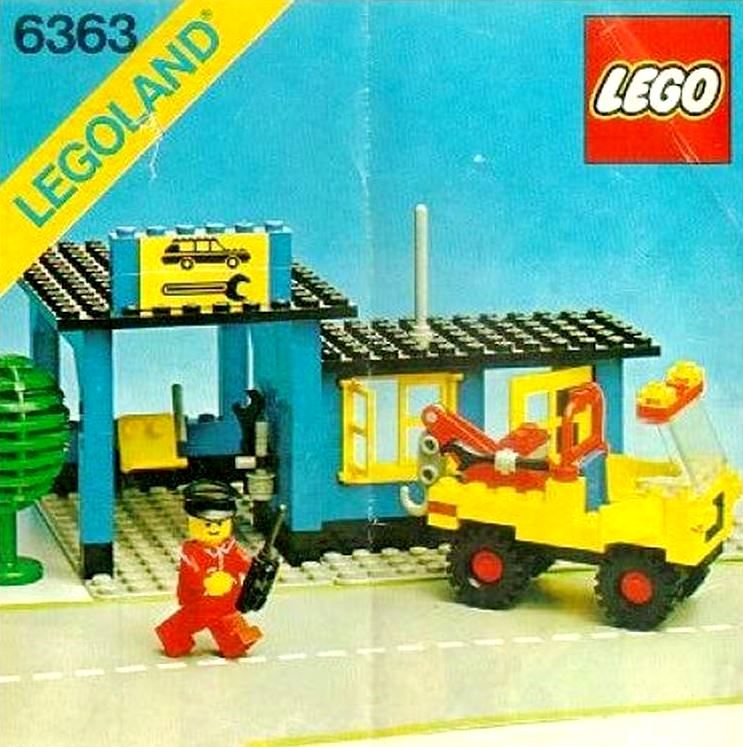
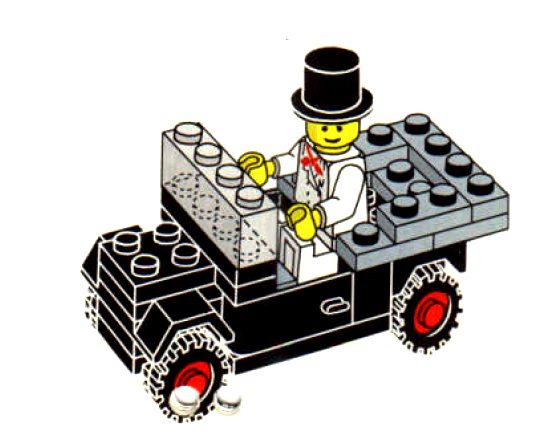
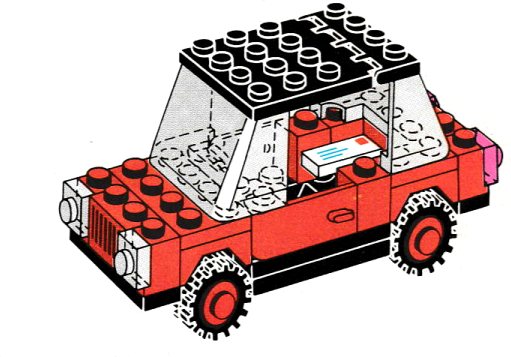
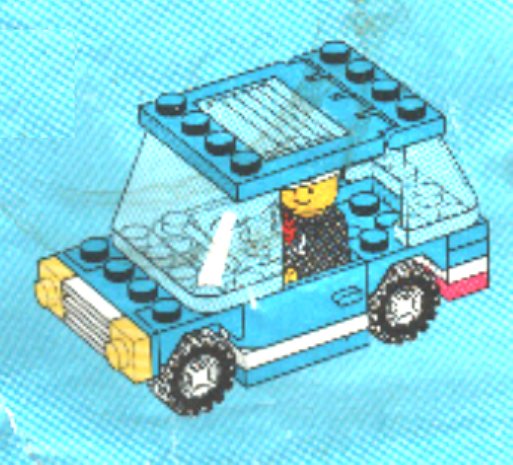
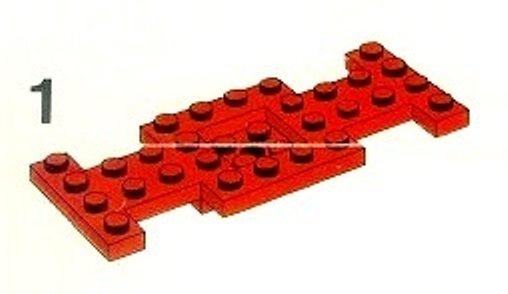
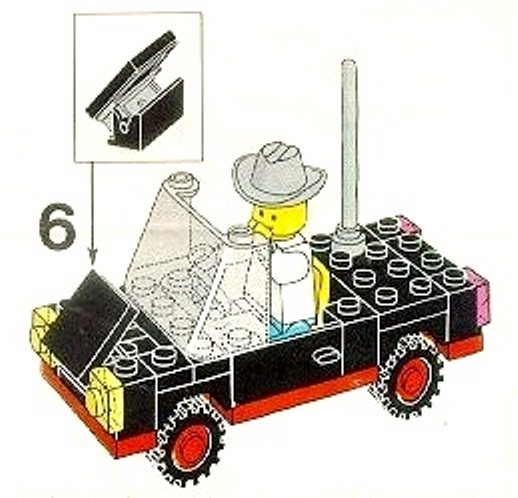
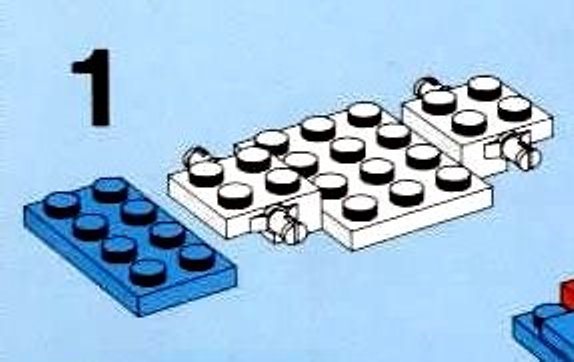
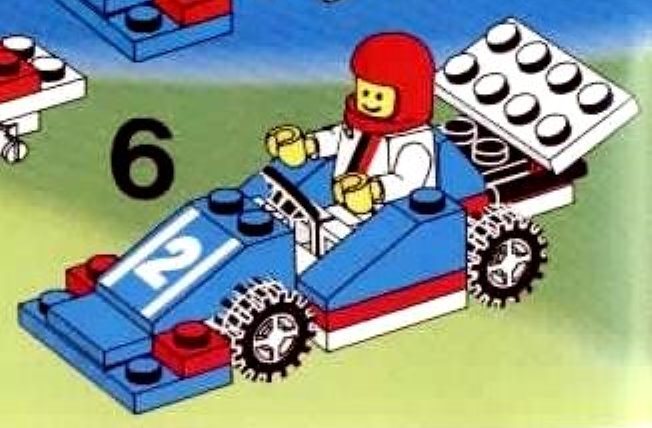
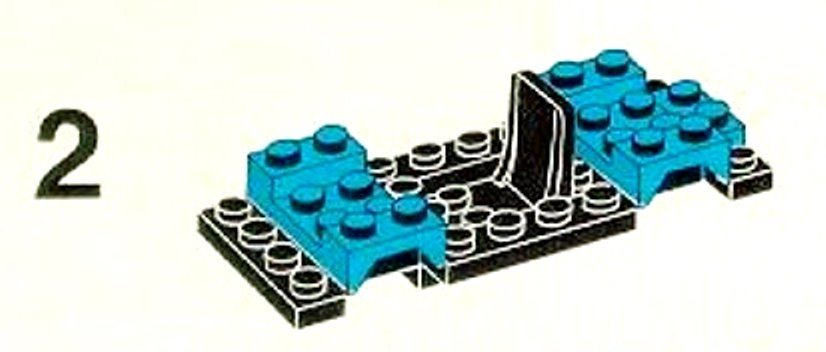
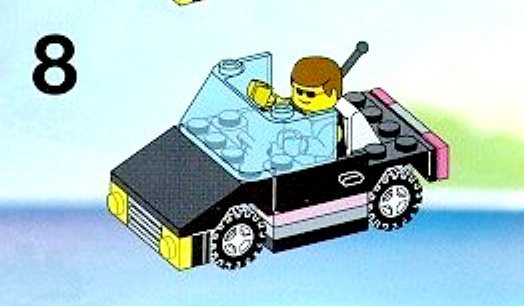
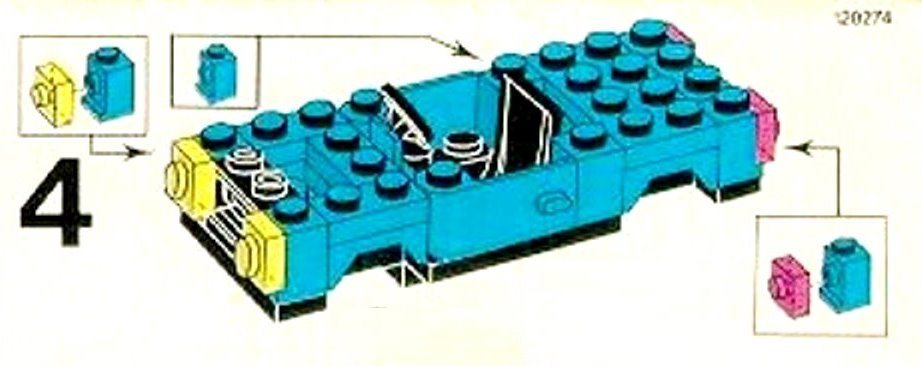
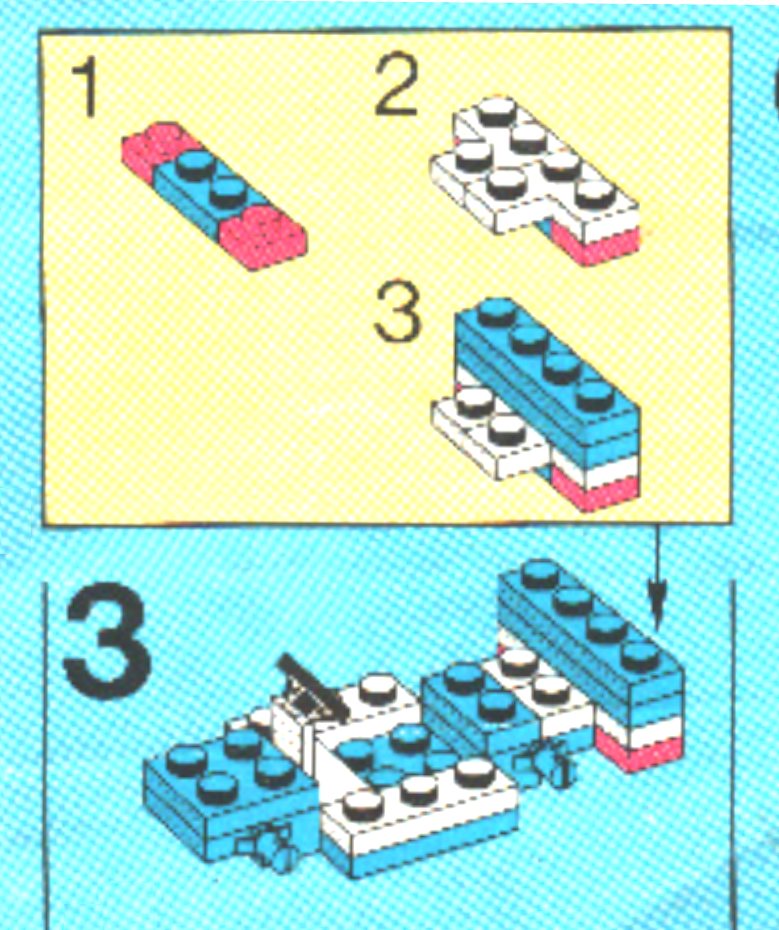
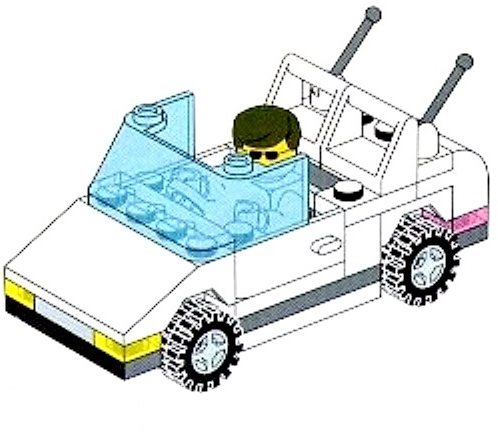
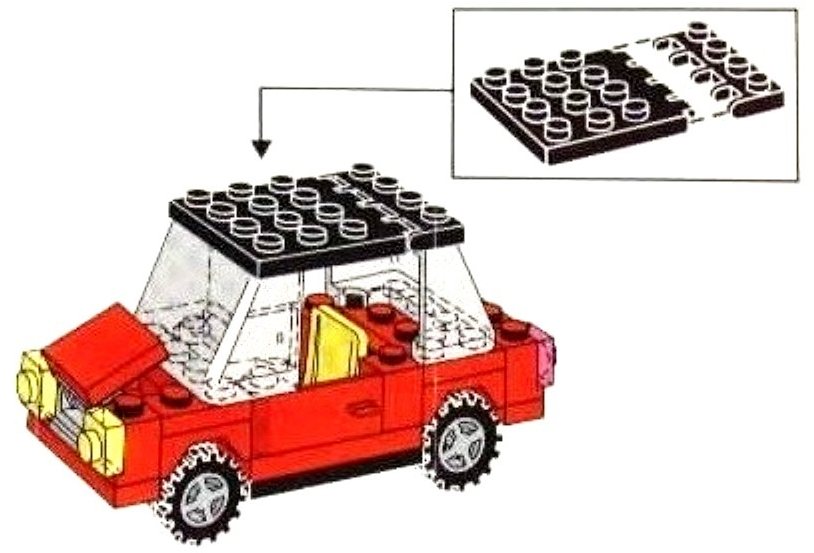
76 comments on this article
More articles like this please!!! I love the historical tag idea
Excellent article!
The best kind of Lego cars.
Love their designs, but new versions of 4 wides are also VERY good. Shame its not so many of them.
@huw
Lovely article as always - keep them coming.
Not to be nitpicking but 6679-1 Dark Shark is not a car. 6679-2 Exxon Tow Truck has a car in it.
Great article! My childhood was defined by 4 wide cars like these. I still love them.
6679 links to a speedboat. A mice set (mine is 3 metres away from me as we speak), but it's not a car.
I also like the taxi in 200 ideas book: shows how passengers can be added to these 4-wide cars.
Most of my 4-wide cars were the open-sided buggy type, with a couple of trucks.
The truck is 6654 is a great little pick-up truck.
What ABSOLUTELY great article! That was peak LEGO!
4xR is currently the smallest body that can easily be achieved, which was the standard for Mighty Micros. These look like they’ve moved on to pull-up pants.
My favorite kind of style. I've built tons of cars like this.
@HOBBES said:
"Not to be nitpicking but 6679-1 Dark Shark is not a car. 6679-2 Exxon Tow Truck has a car in it."
Duplicate set numbers are the bane of my life :)
The 200-2 Idea Book has some great car designs. The micro car, the taxi van, the blue bus and the Shell tanker from pages 22-23 are particularly amazing. There's a few others that look neat too, like a police van, a small mail truck and a tow truck from other pages.
Great article! Needed, wanted by many, i suspect. By the way, i would recommend for those who love vehicles a peek at De Marco Bricks and Wheels.
What a fantastic article! Some absolute favourites of mine highlighted here.
Pleased to see the 2x4 mudguards were still alive and well on 2016’s 30349 - and the 4x5 variant mentioned made it onto vehicles as small as the Jeep-alike in 6369.
I think my 6627 has the centre hole as well, maybe the earlier ones used a different version of the “chassis” part? Also, I reckon that windscreen has been misrecorded as being part of a 1976 set somewhere along the line, it would appear to be the earlier variant with four studs along the top.
6627 Bro looks unusually happy dealing with a break down...
What a great article!
I bought MANY 4-wide vehicles growing up, and still love the style today.
I recently MOC'd a huge 4-wide "Holidays are Coming" Christmas Coca-Cola truck - It's a great scale to work at!
Very nice article! I missed the "Hinge Vehicle Roof Holder 1 x 4 x 2" part, but maybe that was used more for pickups and heavier vehicles. Anyway, thought that was a very useful piece in giving space behind the driver for any head gear, and/or a seat, as well as supplying an attachment point for the hinged roof.
A thoroughly enjoyable article! Thank you @WoutA .
I had some of the earliest cars, but sadly no longer do. They were disassembled and given to charity decades ago.
Lovely article.
One of the issues I have with the modern City vehicles is that they’re so often missing those great door pieces, with just a brick as a replacement.
Those hinged roof pieces were also fantastic.
Great article indeed!
While modern sets obviously work better as display models because of their increased size, all of the new special pieces and more advanced building techniques, the cars of this early minifig era undeniably have a certain charm. And the best thing about them is that they are just like the cars kids would build themselves. Which, combined with all of the alternate builds shown on the box (and the idea books), really encourages kids to do so, instead of just follow the instructions. And everytime a set had some new smart design feature, you would try to incorporate that in other cars.
And indeed, the "Roof holder" part RTS013 mentioned and the 4x5 mudguard plate were very much part of the whole building system, I'd say even more so than both the 4x10 and 4x7 car bases, simply because they offered more flexibility. Even within a uniform system, you want variety.
I don't think it would be a bad idea if for the sets aimed at younger kids Lego would look back on their own history an go a bit back to basics. Less variety of parts (and colors), more uniform building techniques. Learn kids the basics of building with Lego. And later on expand on that with more parts, colors and techniques. Instead, many 4+ use such big and specialized parts it's hard to build something else of it unless you already have more stuff. And even 5+ or 6+ sets often are build in a way kids would never think of themselves.
Great to see the Weetabix set 1484! I sent off for it - you had to collect a certain number of box clippings, so it was a good thing I practically lived on Weetabix at that time. It was my first Legoland set after having a lot of Basic, it seemed so smart and cute in comparison. I never realised this was one of the first sets with that traditional car design. I still have it somewhere.
@gorf43 said:
"6627 Bro looks unusually happy dealing with a break down... "
He has another excuse to go buy the later model....
Love the 4 wdies, of course I grw up with them so Im a bit nostalgic when seeing them. As more accurate as the 6 and 8 wide cards are, LEGO has a real issue with 6 and 8 wide cars in regards to the doors and windshields for them. It appears LEGO finally figured out the wider windshield dimensions with the latest Speed Champion cars, but still have an issue with the doors (which is why Im guessing there is a lack of them) with many of the 6 and now 8 wide cars.
I have fond memories of 6634. Great little set.
imo town would always be better than city and 4 wide would always be better than 6 wide. Especially when small cars and big trucks and buses are all 6 wide. Doesn't make much sense at all.
Thank you for the Flashback to my childhood! Growing up in the '80 was the best.
don't forget the minicar from 6349 Holiday Villa!
The nostalgia goggles are strong with this one! most of these look incredibly dated to me. All True Fans know the peak of Town was in 1993-1995, when all the sets included in Lego Island appeared ;)
It's very alarming to me that Power Miners is now some people's childhood White Whale theme, while to me it's the new upstart garish reboot of Rock Raiders. I guess you love what you grow up with, no matter what it was!
Thanks for the article.
I'd argue that 6 wide trucks look very good, but as others have mentioned, a return to some 4 wide personal cars (and there have been a few) would be a good idea, esp. with the more narrow roads plates now being produced.
@ra226 said:
"I have fond memories of 6634. Great little set."
Me too. Wow, clicking on that link brought back memories. My brother and I took out the extra plate above the rear axle so the car didn't pitch forward. I think I'd still do that.
The tow truck included with the 1986 Shell service station 6378 is worth a mention, basically the standard 10x4 stud car of the era, but with that hinged roof holder found on the vans and lorries.
Just registered so I could mention 6677-1, as I have fond memories of that car. Great article too!
I'd really like to see an article next on the design of classic City cars, 7236 and so on, which appears to have almost completely died out. Also, the "2x4x2/3 bricks with two arches for the wheels" still exist today, just with a technic hole in them that's invisible once the car is assembled.
...Part 2 about classic 4-wide trucks? Besides the awesome 6393 it seems half of the best '80s 4-wide cars and trucks were only found in limited/promotional sets, for example: 1967-2 1572 1590-2
This is my childhood!! I only know bulding 4-stud wide cars with LEGO. When I build 6-stud wide Speed Champions cars, I think that it is fantasy! And with 8-stud wide cars, that is another level!!
Years and years building those small cars, that all the details included in the bigger ones seems unrealistic for me.
Nice article. Can you add some pics of your city with all the cars?
Great article, I like seeing stuff like this.
This is a fun article and I hope you write more articles with "retro" building guides like these! It'd be neat to hear some perspective on building shops, houses, and scenery in the "classic Town" style.
For my part, I haven't built cars of this sort in a long, long time — largely because I grew up in a family of five (two parents, me, and my two brothers), and my parents typically drove big Ford cars, vans, or SUVs so there'd be room for everyone. So as soon as LEGO began moving towards larger-scale vehicles that offered more room for minifigures, they became my go-to for most road vehicle builds.
Even at the larger scale used in today's City theme, though, the 4x7 chassis still remains a great part for go-karts, buggies, and very small cars (the sort classed as "minicompact" in the United States or "A-segment" in Europe). 3177 Small Car and 30568 Skater are good examples of this. By comparison, the 4x10 chassis is not nearly as useful for modern City vehicles since the cutouts it provides for wheels are too narrow to fit larger wheels unless it's jacked up on some oversized suspension (which pretty much defeats the purpose of lowering the driver's seat).
As such, larger 4-wide cars today tend to opt for either the newer 4x12 chassis (https://brickset.com/parts/design-52036), or a custom chassis built around a standard two-stud-wide plate. While my usual preference is for 6-wide cars that can seat two minifigures or mini-dolls side by side, the 4x12 chassis DOES at least makes room for a single passenger behind the driver, which is the bare minimum you'd need for a family car or taxicab.
In any case, there's something nice about knowing that as much as LEGO cars and trucks have evolved, there's still plenty of use for 4-wide vehicles in "modern" LEGO Town/City layouts as well as "classic" ones.
Great article - thank you.
6627 was a groundbreaking set. Glad to see it mentioned.
Excellent article!!
Thank you for a great article! I loved building these cars as a kid since with just a few simple pieces & techniques I could crank out a whole car lot, even if not all at once. 6698 (& the later/larger 6552) show what’s possible for SUV’s. Set 6684 though was my first with part 4211, which gives great techniques to build vans & campers out of. Missing that part, perhaps 6351 is the ultimate expression of classic 4 wide as you can see more modern building techniques coming into play.
For me though, perhaps the best classic 4-wide set is 6625. It finally showed me how part 4474 could be used as a car roof. Something I’d struggled with as a kid to figure out, but knew had to be possible. Of course it is!
I think with new parts in the inventory, Lego can still design beautiful 4 stud cars.
A 4-wide-car set that marked my childhood is 6655 that I got while I was at hospital. There is also 6651 that is (I think) my first Lego set.
"2x4x2/3 bricks with two arches" (part 3788) did indeed disappear in 2010, but not really: it was replaced by a variant with a hole, part 60212, that still exists nowadays.
They released it in modern colors, allowing to make cars in colors that did not exist in the 80s/90s:
https://antp.be/priv/lego/DSC_8227_1.JPG
I still have to get it in dark bluish gray (as well as the doors) and bright light orange to complete my collection.
Not all colors exists for the doors, but panels work well in the meantime (for light aqua, I had to rely on an assembly of bricks with stud on the side + a tile). Sometimes they release a new color, like the reddish brown for the Titanic, so I got one of each side for the car in foreground :)
@antp said:
"A 4-wide-car set that marked my childhood is 6655 that I got while I was at hospital. There is also 6651 that is (I think) my first Lego set.
"2x4x2/3 bricks with two arches" (part 3788) did indeed disappear in 2010, but not really: it was replaced by a variant with a hole, part 60212, that still exists nowadays.
They released it in modern colors, allowing to make cars in colors that did not exist in the 80s/90s:
https://antp.be/priv/lego/DSC_8227_1.JPG
I still have to get it in dark bluish gray (as well as the doors) and bright light orange to complete my collection.
Not all colors exists for the doors, but panels work well in the meantime (for light aqua, I had to rely on an assembly of bricks with stud on the side + a tile). Sometimes they release a new color, like the reddish brown for the Titanic, so I got one of each side for the car in foreground :)"
6655 was also one of our first four-wide cars and really made an impression. I always found the old wheels with metal axles rolled a lot better than the new plastic axles though.
And funny how you can now build cars in a lot more colours while in the real world cars seem to come in less colours: mostly blue, grey and black... :-)
This was so cool! I actually still make cars using the old blue print. I know they're not very lifelike or very good but I say that for play value they're still great.
Also a bunch of cars in the article I have. :)
most of the cars that Lego makes nowadays do not have opening doors...
A beautiful article! The nostalgia is strong; those excerpts from instructions gave me flashbacks to the LEGO of my '80s childhood. Thanks for that!
Four-wide could definitely make a welcome come-back; modern LEGO cars (nevermind the monstrosities that people drive in real life) take up too much space in a city.
Great article, and easy intro for kids into city from creator bricks. I always wanted a car with a sunroof and rear spoiler, I just didn't realize 6590 existed at the time!
I love this, I actually have a specific collection of classic town car parts so that I can build dozens of different classic cars in different colours. They appeal to my nostalgia in a very specific way.
I think the blue car with the sunroof from 1484 was the first bit of lego I 'fell in love' with. I thought this car base was wonderful, was gutted that I never got more. Loved this whole set but that little car (with its little sun roof) was just wonderful <3
Excellent article! I never really noticed there was such variety in the cars from that era. To me it always seemed like they were very cookie-cutter due to the limited amount of freedom you get when you use so many specialized parts. But there's surprising variety beyond my 6655 Car Repair...
These are the cars of my youth! Absolutely love the features crammed into such small vehicles: opening doors, opening bonnets, sunroofs, hinged roof minifigure access without having to partially disassemble the car...
Doors in particular add so much play/poseability value, whether or not they're of any actual use to get a minifigure inside.
Great article @WoutA , and a great Instagram. Certainly a lot of excellent sets in the 70s/80s. Although I must confess my absolute favourite classic town era was 1969 to the early 70s, when the main significant new part was the mini-wheel... a bit of a life changer.
> @cm5878 said:
> I think my 6627 has the centre hole as
> well, maybe the earlier ones used a different version of the “chassis” part? Also, I reckon
> that windscreen has been misrecorded as being part of a 1976 set somewhere along the
> line, it would appear to be the earlier variant with four studs along the top. ]]
Actually the illustration for the 6627 used in this article shows a centre hole, and I think my 6627 had a centre hole.
Lovely article @WoutA.
I don't think I've ever been aware of the 3x4x1 mudguard part. Definitely from an era when 'cars of the future' where all big old cheese wedges of metal :D
Great article. Hits me right in the nostalgia.
Wonderful article! Great memories from long ago childhood, but also nice piece of Lego history.
The cars from back then were also a bit more blocky or simple in design, so these Lego cars didn’t seem so far off (certainly because of our imagination as kids back then).
Big thanks to the author WoutA (fellow country man also!)
I loved the 6627 convertible set; it seemed very exotic back then with the opening bonnet (hood) thing going on - takes me back to classic town road plates and being 7 again...
Thanks for the great article - nice to see when everything was simpler and all of the realism needed came from your imagination!
@gorf43 said:
"6627 Bro looks unusually happy dealing with a break down... "
He's just lovingly admiring the engine.
The old ME Models – I think they've discontinued selling custom sets – had a bunch of these classic cars available for sale. Each with a minifigure (classic, of course). Had a line of houses as well.
Superb article!
Great article Huw.
I remember some years back at a Lego show at ExCel in London (I think you were there), someone had built ‘updated’ versions on Lego sets from this era. They’d used newer techniques and parts to recreate the buildings make the vehicles six wide. They looked really good too.
Their display had both old and new versions.
@Andhe:
That was the Jack Stone era of automotive design. I know the F-40 was insanely fast for its time, but it’s one of the butt-fugliest cars I’ve ever seen. It doesn’t deserve to wear the color red, much less the Ferrari logo. But what I really blame for that is the Dodge Charger Daytona and Plymouth Superbird, which are basically the automotive equivalent of mullets.
Golden ages of lego. Maybe the cars could be build from 20+ pieces but is was much better fun than the modern ones.
The 2 x 4 mudguard lives on, albeit with an axle hole, to this day.
https://www.bricklink.com/v2/catalog/catalogitem.page?P=60212
That was a great read. Thank you so much.
@antp said:
"A 4-wide-car set that marked my childhood is 6655 that I got while I was at hospital. There is also 6651 that is (I think) my first Lego set.
"2x4x2/3 bricks with two arches" (part 3788) did indeed disappear in 2010, but not really: it was replaced by a variant with a hole, part 60212, that still exists nowadays.
They released it in modern colors, allowing to make cars in colors that did not exist in the 80s/90s:
https://antp.be/priv/lego/DSC_8227_1.JPG
I still have to get it in dark bluish gray (as well as the doors) and bright light orange to complete my collection.
Not all colors exists for the doors, but panels work well in the meantime (for light aqua, I had to rely on an assembly of bricks with stud on the side + a tile). Sometimes they release a new color, like the reddish brown for the Titanic, so I got one of each side for the car in foreground :)"
That is one nice picture right here. Great job! Also thanks to you and the other people pointing out the 2x4 mudguard lives on - I had no idea since I literally don't own a single post-2000 LEGO brick :-D
@WoutA :
How very sad for you. A lot of the best parts didn’t happen until the 21st century.
I love these classic cars. I built many of them back in the day. Working on getting my town set up for my son. I'll have one section be all 80s sets I grew up with...the "older" section of town. Will be set up just like I had it back in the day. Newer sets will expand out from there...with a downtown section made up of all the modular buildings.
@PDelahanty:
I would do such terrible things to that section of a layout. Every lot would be overgrown with weeds, cars would be up on bricks with their wheels missing, 3/4 of the minifigs would be getting mugged...
Ths was/is one of the most enjoyable and useful articles I have read here on Brickset! Thank you for walking thru all of the variations and parts/pieces used for these style of vehicles.
@PurpleDave said:
" @PDelahanty:
I would do such terrible things to that section of a layout. Every lot would be overgrown with weeds, cars would be up on bricks with their wheels missing, 3/4 of the minifigs would be getting mugged..."
Okay, you've given me some good ideas... :)
Great article. Hope to see more :)
At the moment I 'm researching little cars with a 4x7 vehicle base, that's why I came here... And found your article, which is amazing ! This is gonna be very helpful, I'm gonna try to build a small electric car. Thank you.
I loved building 4 stud and 3 stud cars. I have a lot of piece 30029 so I often build on those.
I love good old cars designs. I still prefer the tradition, that cars = 4 studs, larger cars = 6 studs, trains = 6 studs. Planes of 4 studs wide perhaps are a bit too small, but nevertheless they offer a lot of cool opportunities to be rebuild into something else.
Old smaller bikes were also absolutely fantastic.
Nice article! That's what I hope to see in Brickset.